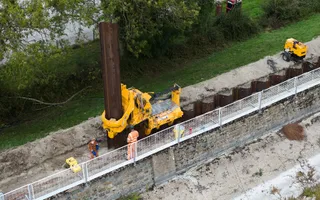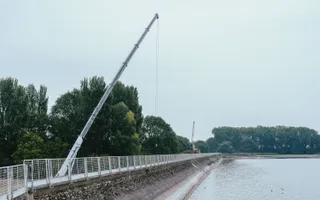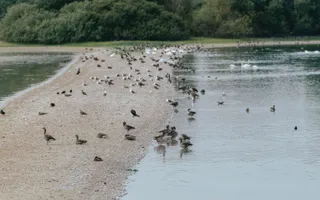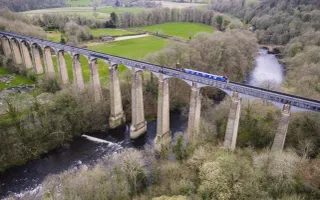The project, estimated to cost £6 million, will start in mid-January with site preparations. Work to install two thousand 11-metre-long steel sheet piles into the reservoir’s two 200-year old embankments, will begin in June. Stretching for 1,350 metres, the embankments at Wilstone Reservoir are one of the longest of the 71 major reservoirs in the Trust’s care.
Embankment strengthening works planned at Wilstone Reservoir
We're planning a 15-month programme of statutory works to strengthen the embankments at Wilstone Reservoir, near Tring in Hertfordshire.
Transcript
Wilstone Reservoir is around 200 years old now. The embankments themselves need some maintenance and repair, so what we're doing here today is creating a new sheet pile wall within the earthworks. Wilstone Reservoir is incredibly important for a number of reasons. It was originally constructed to feed water to the canal so that we can use boats on the navigation, but it's also an important local resource as well for people and wildlife. What we're doing today is hopefully safeguarding its future for the next hundred years and more.
The work at Wilstone Reservoir is being undertaken completely from dry land. Our cranes are situated just outside of the reservoir and they pitch the piles, that is, lift the piles, to the piling machine. It's important that we've done the work this way. The alternatives would have involved possibly draining the reservoir completely, which aside from having an enormous impact on navigation and operation of the canal, would also be of detriment to the environment. So, we've planned the works at Wilstone Reservoir specifically so that we can take advantage of the reservoir naturally decreasing in level as the summer goes on, allowing us to do the works without causing any major disruptions or impacts to the environment.
Wilstone Reservoir feeds the canal through a pumping station which is at Tring. There are currently electric pumps situated there, and they draw the water out of Wilstone and put it into the summit pound of the Grand Union. From there, when people use a lock, water goes down through the lock and along the canal. So it's a constant process of refilling the canal from the top and allowing the water to come down the navigation.
Wilstone Reservoir has quite an interesting history. It was originally built on a much smaller scale, and since then, within about 10 to 20 years, it was extended twice, reflecting the use of the canal and ensuring that there was enough water for the boats.
The work that we're doing at Wilstone Reservoir right now is incredibly important. It’s so important that the Canal & River Trust actually funds this work and makes sure that it happens. By doing so, we're making Wilstone Reservoir resilient for the future. The works that we're doing are going to take Wilstone into the next 100 years and beyond and make sure that Wilstone Reservoir can continue to be a vital piece of navigational infrastructure, keeping the Grand Union Canal open for everyone to enjoy.


Update November 2025
While we continue work to the collector drains and culvert, the road next to Wilstone Reservoir car park (a section of Lower Icknield Way) will remain partially closed with one lane closed and traffic lights in place until 14 December.
In January we’ll begin removing stone from the site, used to create a temporary access track. Around 20 lorries a day will be taking this stone away for around five weeks. The lorries will remain on the main roads. Some of the stone will be re-used locally.
Wilstone Reservoir car park will remain closed while work continues to level and resurface the footpath that runs along the top of the reservoir embankment. We will also replace the steps leading to the footpath from the car park. The car park is scheduled to re-open by March 2026.
The whole project is currently on track to be completed by the end of March 2026.
Update October 2025
The piling work to strengthen the reservoir embankments and syphon will be completed this week.
The road next to Wilstone Reservoir car park (a section of Lower Icknield Way) partially re-opened on Monday 20 October, with one lane still closed and traffic lights in place while work continues. These restrictions are likely to be in place until November 2025.
Wilstone Reservoir car park will remain closed while work continues to level and resurface the footpath that runs along the top of the reservoir embankment. We will also replace the steps leading to the footpath from the car park. The car park is scheduled to re-open by March 2026.
The collector drains at the toe of the reservoir embankment are also going to be upgraded. These drains monitor any signs that the reservoir is leaking. And we’ll be carrying out work underground to repair and re-line the 200-year culvert that is still used to draw off water from the reservoir in emergencies. This 300-metre long brick lined structure runs from the north east corner of the reservoir down and beneath Lower Icknield Way.
The whole project is currently on track to be completed by the end of March 2026.
Update August 2025
Piling work started at the end of June and is so far progressing well. This element of the work is expected to be completed by November.

We will close Wilstone Reservoir car park at the beginning of September for around seven months. The road alongside it will be closed for around four weeks in September. A traffic diversion will be in place, but the farm shop and café remain accessible throughout.


Project update May 2025
Wilstone Reservoir embankment strengthening works update
Work to create a temporary vehicle access track has begun.
We expect to start the piling work at the end of June, starting at the north east corner of the reservoir. This will require closure of the footpath along the top of the reservoir dam. Pedestrians will be diverted through the field next to the reservoir, maintaining access to the farm shop and café.
We plan to close the Wilstone Reservoir car park in early September for around four months, while we complete the piling work and build a new footpath along the top of the dam.
We will also need to temporarily close the road next to the car park for a short amount of time, while work is taking place on the reservoir dam. A traffic diversion will be in place, but the farm shop and café will remain accessible. More details of the dates and duration of the closure will be published shortly.
The piling work is expected to take around five months.
Explaining the timing of the works – working with nature
The work to strengthen the embankments at Wilstone Reservoir is taking place over the summer months so we can work with the natural trend of the reservoir’s water levels. It’s a groundwater-fed reservoir, rather than rainwater-fed, and the early months of the year are when it naturally refills.
We expect the reservoir’s level to have dropped by the autumn, following the drier summer months and increased boat movements on the Grand Union Canal. In the autumn we plan to carry out works to the outfall syphon that require lower water levels.
The piling will be completed by Christmas, allowing the reservoir to naturally refill as usual in the new year.
Project update March 2025
Wilstone Reservoir Embankment Strengthening Works Update
Vegetation management work has been completed, required to create access space for our construction plant and materials. Work to create a temporary vehicle access track is expected to get underway after Easter and is likely to take several weeks. The main piling work is planned to begin in late May. Ahead of this phase, we’ll need to close the footpaths and car park at Wilstone Reservoir. We’ll issue another update ahead of this phase of the project confirming the exact date. Footpath diversions will be in place.
Local road closures won’t be needed until later in the summer. We’ll publish details of these as soon as possible, and the closures will be as short as possible.
The reservoir’s water level is currently at the level required to facilitate the works.
Wilstone Reservoir
Wilstone Reservoir is part of the Tring Reservoirs Nature Reserve Site of Special Scientific Interest (SSSI). Originally built to supply water to the Grand Union Canal, the reservoirs are now also one of the best birdwatching spots in southern England. The four individual reservoirs in the Tring Reservoirs Nature Reserve are Startop’s End, Marsworth, Tringford and Wilstone. The Herts & Middlesex Wildlife Trust leases and manages the Tring Reservoirs, and we maintain operational responsibilities.
Built in 1802 to supply water to the Wendover Arm of the Grand Union Canal, Wilstone Reservoir is the largest of the four reservoirs at 119 acres (48 hectares). It is up to 18 feet (5.5 metres) deep and has the capacity to hold over 1000 mega litres of water, the equivalent of over 450 Olympic sized swimming pools. The reservoir has two five-metre wide embankments stretching for a total of 1,350 metres and ranging in height from two to eight metres.

An important place for water storage
Ros Daniels, our London & South East director, explains: “Wilstone Reservoir provides an important place for water storage to feed the Grand Union Canal and has also become a popular site for angling, walking and bird watching.
“This winter we’ll begin a programme of essential maintenance work to strengthen the reservoir’s embankments, securing it for the future. These are statutory safety works required under the Reservoir Act.
“To minimise disruption, the reservoir won’t be drained during the works but the water level will be lowered by 0.5 metres below capacity. The reservoir will continue to supply water to the canal, and the water level in the reservoir will slowly reduce throughout the summer, as is usual. Our engineering project team will use land-based equipment to carry out the works and, to minimise disruption, will include a silent piling machine.
“Unfortunately, the nature of the work will mean that the reservoir’s footpaths and car park will need to be temporarily closed, as well as some local roads for short periods of time. It won’t be possible to fish at the reservoir during the main construction element of the works from May 2025 to March 2026.
“The reservoir is an important wildlife site and we’ll be making a number of habitat improvements to the reed beds as well as replacing nine small and medium-sized trees and coppiced hedgerow which unfortunately will have to be removed in order to carry out the works.”
For more information please call us on 0303 040 4040 or visit our ways to contact us page.
Last Edited: 24 November 2025


Stay connected
Sign up to our newsletter and discover how we protect canals and help nature thrive


